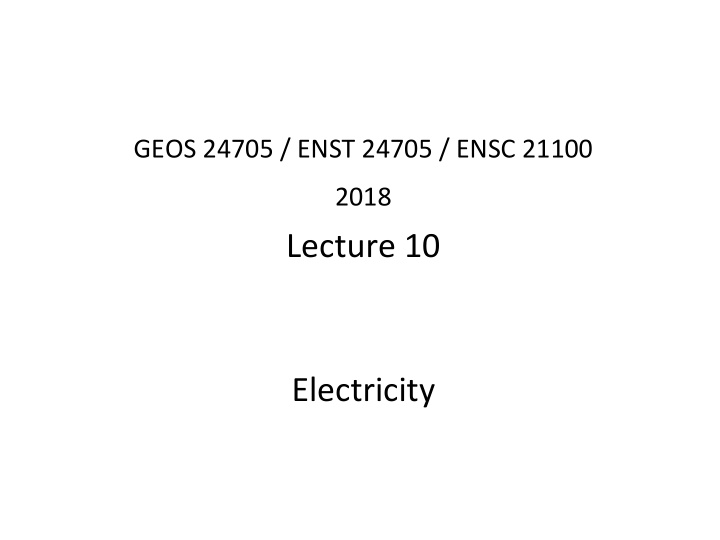



GEOS 24705 / ENST 24705 / ENSC 21100 2018 Lecture 10 Electricity
Electricity not only transports kine@c energy It also allows doing work more flexibly: engine and motor characteris@cs can differ Kine@c ------ (generator) -----------> Electrical -------- (motor) --------> Kine@c
1/3 of total primary energy now goes to make electricity 61% through heat engine total e ~ 32% transporta@on e ~ 21% turbines e ~ 23% ? (likely underes@mate of thermal efficiency)
All current use of steam: turbines spin generators to make electricity Steam turbines are choice for external combus5on All reciproca@ng engines are now internal combus5on (with some minor excep0ons)
History of electricity technology
Sta5c electricity discovered in ancient 5mes Word origin: “electricity” from New La@n “electricus”, constructed (1600, Gilbert, De Magnete ) from La@n electrum, “amber”, from Gr. “ilektron” Thaleus of Miletus describes 585 BC that amber rubbed with fur could aaract other objects Kine%c energy à electrical energy: separate charge Image from: Wikimedia commons
Sta5c electricity discovered in ancient 5mes Word origin: “electricity” from New La@n “electricus”, constructed from La@n electrum, “amber”, Gilbert De Magnete, 1600 1730s: Hauksbee shows that rubbing 1660, von Guericke, electrosta@c “generator” amber in a chamber containing mercury vapor causes light emission Kine%c energy à electrical energy: separate charge Images from: “The History of Electrosta0c Generators”
Sta5c electricity discovered in ancient 5mes Word origin: “electricity” from New La@n “electricus”, constructed from La@n electrum, “amber”, Gilbert De Magnete, 1600 1795s: experiments with electrosta@c capacitors (store charge on metal) 1750s, demonstra@on of sta@c electricity discharge: “electric kiss” Kine%c energy à electrical energy: separate charge Images from: “The History of Electrosta0c Generators”
Chemical reac5ons can create electric currents Allessandro Volta – demonstrated 1791, “Voltaic pile” 1800 Voltaic pile was stack of different metals (Zn, Cu) soaked in brine (inspired by Galvani’s accidental finding). Chemical energy à electrical energy: metal oxidizes Images from: Wikipedia, BaFeryfacts.co.uk
Electricity enters the popular imagina5on Allessandro Volta – demonstrated 1791, “Voltaic pile” 1800 Luigi Galvani frog experiment, 1792 Mary Shelley, 1818
How do you get useful work from electricity? Intersec@on of electricity and magne@sm allows transforma@on of electrical energy to / from work “dynamic electricity” = flow of steady current
Electric currents can create magnetic fields https://www.youtube.com/ watch?v=V-M07N4a6-Y Electromagnet, 1824 (Sturgeon)
Electricity research started with motors (first powered by baFeries) Rota@ng electromagnet, Wm. Ritchie, 1833 Rota@ng electromagnet, Wm. Sturgeon, 1838 Rota@ng wire in Hg, Faraday, 1830s Reciproca@ng engine, Daniel Davis (?) 1840s DC electric fan, Edison 1898 Revolving armature engine, Daniel Davis 1848 Images from: Sparkmuseum
Recommend
More recommend